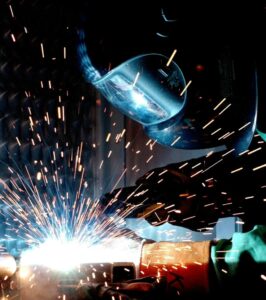Table of Contents
- An Introduction to Underwater Welding
- What Daily Life Looks Like for Underwater Welders
- Essential Skills and Qualifications
- Training and Education Requirements
- Common Work Environments and Safety Concerns
- Earning Potential and Job Outlook
- Challenges and Rewards in the Industry
- Looking Ahead: Future Opportunities in Underwater Welding

An Introduction to Underwater Welding
Underwater welding offers a rare blend of excitement, skill, and challenge, making it a career that stands apart from both traditional welding and standard commercial diving. Those drawn to this field are often interested in unconventional work settings, such as shipyards, oil platforms, port facilities, or remote underwater infrastructure. Hyperbaric welding encompasses both “wet welding,” performed directly in the water, and “dry welding,” done inside specially constructed pressure chambers. Both types share a common need for top physical conditioning, nerves of steel, and a knack for adapting quickly to complex environments.
For many who are considering this line of work, questions about pay and career trajectory arise early. Factors such as geographic region, skill level, and the inherent dangers associated with deep-sea labor significantly impact salaries. For a realistic look at compensation expectations across experience levels and the types of roles available, consult this detailed underwater welder salary guide. Understanding the financial prospects is as important as grasping the day-to-day demands since the realities of pay, overtime, and benefits can influence one’s decision to enter or stay in the profession.
The Bureau of Labor Statistics’ welding occupations overview highlights that welding careers, in general, tend to offer stable employment. However, underwater welding is recognized as a niche skill set, demanding more rigorous preparation and offering different rewards compared to land-based welding. The combination of technical know-how, physical endurance, and specialized safety training positions underwater welders as some of the most versatile professionals in the skilled trades.
What Daily Life Looks Like for Underwater Welders
Life as an underwater welder is far from monotonous, and no two days on the job are quite alike. Mornings may start long before sunrise, with welders gathering for safety briefings and equipment inspections. Every tool, from diving helmets to welding torches, is meticulously checked because even the smallest oversight underwater can lead to serious complications. Depending on the assignment, divers can find themselves patching up pipelines deep beneath the waves, performing maintenance on offshore wind turbines, or conducting underwater inspections on submerged bridge supports.
Actual dive times fluctuate depending on depth, project complexity, and environmental risks. Welders navigate murky waters, cold temperatures, and strong currents—all while maintaining focus on precision welding tasks. The ability to remain calm and function in zero-visibility conditions is essential. After each dive, strict decompression procedures are followed to minimize the risk of “the bends,” a potentially life-threatening condition. The unpredictability of natural elements is a constant companion, meaning welders must always be prepared to adapt and think on their feet. All of these challenges foster a strong sense of camaraderie, as divers rely heavily on each other for safety and success.
Essential Skills and Qualifications
- Physical Stamina and Fitness: The underwater environment requires remarkable endurance. Carrying gear, battling currents, and performing strenuous tasks demand a high level of physical fitness.
- Technical Precision: Welding underwater presents its own set of hurdles, with limited visibility and unique material challenges. Steady hands, sharp eyes, and an eye for detail are crucial.
- Safety Awareness: The following protocol protects welders from hazards such as electric shock or decompression sickness. Vigilance is the best safeguard against the many potential risks in the field.
- Problem-Solving: Underwater projects rarely go exactly as planned. Quick thinking and innovative solutions are vital when faced with unforeseen obstacles or equipment malfunctions.
- Communication: Effective communication with topside teammates ensures every step of an operation runs smoothly. Signaling, hand gestures, and specialized communication systems are all part of the job.
Beyond physical and technical ability, certifications for both commercial diving and welding are standard prerequisites in the industry. Candidates should have completed recognized training and possess up-to-date first aid and safety credentials. Only those who combine mental focus, discipline, and a proactive attitude tend to thrive over the long haul.
Training and Education Requirements
Entering the field of underwater welding almost always requires formal education in both commercial diving and welding. Accredited programs introduce students to critical topics, including underwater cutting techniques, hyperbaric chamber use, dive medicine, safety regulations, and the mechanical principles underlying welding processes.
Many aspiring underwater welders sharpen their skills with internships or apprenticeships, working side-by-side with seasoned professionals. Real-world training is highly valued in this career, often proving as important as classroom time. As outlined in Dive News Wire’s underwater welding guide, the combination of rigorous schooling and hands-on experience leads to the best long-term results. Graduates of reputable programs emerge better prepared for the hazards and intricacies unique to submerged environments.
Common Work Environments and Safety Concerns
Underwater welders work in a variety of challenging settings, from bustling shipyards and remote offshore oil rigs to hydroelectric dams and industrial reservoirs. Each setting presents its own unique set of safety considerations, including working at low temperatures, navigating confined spaces, and protecting oneself from electrical hazards. Remote jobs often require welders to live on-site for extended periods, which adds another layer of challenge.
Risks include decompression sickness, equipment failure, entanglement, and, occasionally, encounters with underwater wildlife. Strict safety protocols are enforced before, during, and after every dive. Pre-dive checklists, buddy systems, and routine safety drills are daily norms. A focus on safety is reflected in every aspect of the job, with regular training updates to keep everyone aware of evolving hazards and best practices.
Earning Potential and Job Outlook
Earning potential in underwater welding is wide-ranging, shaped by numerous factors such as region, experience, type of employer, and task difficulty. Those new to the industry may begin with modest salaries, but with advanced certifications, proven expertise, and a reputation for reliability, significant increases are possible. Depth pay—additional compensation for working at greater depths or in high-risk environments—can also boost income.
Project type also makes a difference; offshore positions or jobs requiring specialized knowledge of hazardous materials may offer premium wages. The unpredictability of work schedules and overtime opportunities contributes to fluctuating annual earnings. The market outlook remains positive, driven by ongoing infrastructure needs, offshore energy development, and global investment in maritime projects. Skilled underwater welders are expected to stay in high demand wherever underwater construction and repair are essential.
Challenges and Rewards in the Industry
The demands of underwater welding go far beyond just technical skill; they encompass a wide array of factors that test both the body and the mind. Physically grueling shifts that can extend for hours or even days, remote deployments to various locations, and extended periods away from loved ones are just some of the common realities that underwater welders face. These professionals often find themselves working in harsh conditions where environmental stresses, such as bone-chilling cold water, overwhelming darkness, and unpredictable currents, constantly test both stamina and resolve.
Emotional resilience and the ability to effectively manage stress are traits that managers cite as crucial for maintaining longevity and success in this challenging field. The psychological demands of the job can sometimes feel just as overwhelming as the physical ones, requiring a unique blend of mental fortitude and adaptability.
Despite these daunting challenges, underwater welders often speak passionately about the intrinsic rewards that come from completing complex assignments and collaborating with elite project teams. The sense of satisfaction derived from overcoming obstacles and finding solutions in high-pressure environments can be tremendously fulfilling. The diversity of projects undertaken by underwater welders—ranging from repairing critical infrastructure to engaging in innovative construction tasks—provides abundant opportunities for professional growth and advancement.
Moreover, the strong community bonds formed among welders serve as a source of support, enhancing motivation and fostering a sense of camaraderie. There’s a distinct pride that comes with contributing to infrastructure and projects that may not be immediately visible but are crucial for daily life. By supporting everything from busy shipping lanes to national power grids, underwater welders play an essential role in ensuring the functionality and safety of systems that many rely on but rarely see. This combination of challenge, community, and contribution makes underwater welding a uniquely rewarding profession for those who choose to pursue it.
Looking Ahead: Future Opportunities in Underwater Welding
The underwater welding industry is being shaped by technological shifts, including the adoption of robotics and remotely operated vehicles (ROVs). While these tools are expected to streamline certain repetitive or dangerous tasks, the need for expertly trained human welders remains strong. On-site assessments, troubleshooting, and high-skill welding repairs still require a personal touch and deep expertise.
As more countries invest in sustainable energy infrastructure and modernize aging ports and bridges, job prospects look bright. Training programs are increasingly incorporating digital skills and robotics modules, ensuring that new entrants are prepared to keep pace with the industry’s ongoing evolution. For those willing to continually upgrade their skills and adopt new methods, underwater welding offers enduring career opportunities and a chance to contribute to vital projects worldwide.



